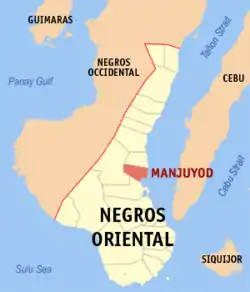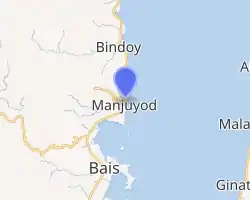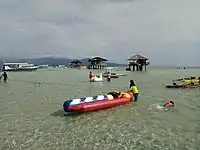Manjuyod
Manjuyod, officially the Municipality of Manjuyod, is a 2nd class municipality in the province of Negros Oriental, Philippines. According to the 2015 census, it has a population of 42,332 people. [3]
Manjuyod | |
|---|---|
| Municipality of Manjuyod | |
 Map of Negros Oriental with Manjuyod highlighted | |
OpenStreetMap 
| |
.svg.png.webp) Manjuyod Location within the Philippines | |
| Coordinates: 9°41′N 123°09′E | |
| Country | |
| Region | Central Visayas (Region VII) |
| Province | Negros Oriental |
| District | 1st district |
| Barangays | 27 (see Barangays) |
| Government | |
| • Type | Sangguniang Bayan |
| • Mayor | Felix A. Sy |
| • Vice Mayor | Raffy Alipio S. Andaya |
| • Representative | Jocelyn S. Limkaichong |
| • Electorate | 28,993 voters (2019) |
| Area | |
| • Total | 264.60 km2 (102.16 sq mi) |
| Elevation | 82 m (269 ft) |
| Population | |
| • Total | 42,332 |
| • Density | 160/km2 (410/sq mi) |
| • Households | 9,923 |
| Economy | |
| • Income class | 2nd municipal income class |
| • Poverty incidence | 41.08% (2015)[4] |
| • Revenue | ₱119,900,605.93 (2016) |
| Time zone | UTC+8 (PST) |
| ZIP code | 6208 |
| PSGC | |
| IDD : area code | +63 (0)35 |
| Climate type | tropical climate |
| Native languages | Cebuano Tagalog |
Barangays
Manjuyod is politically subdivided into 27 barangays.
- Alangilanan
- Balaas
- Bantolinao
- Bolisong
- Butong
- Campuyo
- Candabong
- Concepcion
- Dungo-an
- Kauswagan
- Libjo
- Lamogong
- Bagtic
- Maaslum
- Mandalupang
- Panciao
- Poblacion
- Sac-sac
- Salvacion
- San Isidro
- San Jose
- Santa Monica
- Suba
- Sundo-an
- Tanglad
- Tubod
- Tupas
Climate
| Climate data for Manjuyod, Negros Oriental | |||||||||||||
|---|---|---|---|---|---|---|---|---|---|---|---|---|---|
| Month | Jan | Feb | Mar | Apr | May | Jun | Jul | Aug | Sep | Oct | Nov | Dec | Year |
| Average high °C (°F) | 29 (84) |
29 (84) |
30 (86) |
32 (90) |
31 (88) |
30 (86) |
30 (86) |
30 (86) |
30 (86) |
30 (86) |
29 (84) |
29 (84) |
30 (86) |
| Average low °C (°F) | 23 (73) |
23 (73) |
23 (73) |
24 (75) |
25 (77) |
25 (77) |
24 (75) |
24 (75) |
24 (75) |
24 (75) |
24 (75) |
23 (73) |
24 (75) |
| Average precipitation mm (inches) | 35 (1.4) |
28 (1.1) |
38 (1.5) |
51 (2.0) |
125 (4.9) |
195 (7.7) |
194 (7.6) |
173 (6.8) |
180 (7.1) |
192 (7.6) |
121 (4.8) |
64 (2.5) |
1,396 (55) |
| Average rainy days | 9.2 | 8.2 | 9.9 | 11.3 | 22.5 | 27.3 | 28.0 | 27.2 | 27.1 | 26.9 | 19.7 | 12.7 | 230 |
| Source: Meteoblue (Use with caution: this is modeled/calculated data, not measured locally.) [5] | |||||||||||||
Demographics
| Year | Pop. | ±% p.a. |
|---|---|---|
| 1903 | 8,289 | — |
| 1918 | 14,728 | +3.91% |
| 1939 | 25,581 | +2.66% |
| 1948 | 25,190 | −0.17% |
| 1960 | 18,456 | −2.56% |
| 1970 | 20,545 | +1.08% |
| 1975 | 22,949 | +2.24% |
| 1980 | 26,257 | +2.73% |
| 1990 | 31,989 | +1.99% |
| 1995 | 34,545 | +1.45% |
| 2000 | 37,863 | +1.99% |
| 2007 | 39,722 | +0.66% |
| 2010 | 41,107 | +1.26% |
| 2015 | 42,332 | +0.56% |
| Source: Philippine Statistics Authority [3] [6] [7][8] | ||
Tourism

The town is known for the Manjuyod White Sandbar, often dubbed as the "Maldives of the Philippines"
Tourist attractions in Manjuyod include the Himampangon Cave, a natural rock formation; the white sand bar, a narrow seven kilometer strip of white beach sand; and the Candabong forest, there are many species living in Candabong forest which is protected by the government.
Festival
Saint Francis of Assisi is the patron saint of Manjuyod, and his feast day is celebrated annually October 4 with the town fiesta. The fiesta is an official non-working holiday for the town.
References
- Municipality of Manjuyod | (DILG)
- "Province:". PSGC Interactive. Quezon City, Philippines: Philippine Statistics Authority. Retrieved 12 November 2016.
- Census of Population (2015). "Region VII (Central Visayas)". Total Population by Province, City, Municipality and Barangay. PSA. Retrieved 20 June 2016.
- "PSA releases the 2015 Municipal and City Level Poverty Estimates". Quezon City, Philippines. Retrieved 12 October 2019.
- "Manjuyod: Average Temperatures and Rainfall". Meteoblue. Retrieved 6 May 2020.
- Census of Population and Housing (2010). "Region VII (Central Visayas)". Total Population by Province, City, Municipality and Barangay. NSO. Retrieved 29 June 2016.
- Censuses of Population (1903–2007). "Region VII (Central Visayas)". Table 1. Population Enumerated in Various Censuses by Province/Highly Urbanized City: 1903 to 2007. NSO.
- "Province of". Municipality Population Data. Local Water Utilities Administration Research Division. Retrieved 17 December 2016.
External links
| Wikimedia Commons has media related to Manjuyod. |
This article is issued from Wikipedia. The text is licensed under Creative Commons - Attribution - Sharealike. Additional terms may apply for the media files.